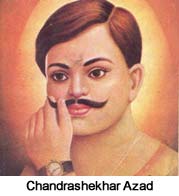

 |  |
 The revolutionary terrorists were severely suppressed during World War I, with most of their leaders in jail or absconding. Soon after, the National Congress launched the non-cooperation movement and on the urging of Gandhiji, C.R. Das and the other leaders most of the revolutionaries either joined the movement or suspended their own activities. But the sudden suspension of the non-cooperation movement left them disillusioned. They were not attracted by the parliamentary politics of the swarajists. Many were drawn to the idea that violent methods alone could free India.
The revolutionary terrorists were severely suppressed during World War I, with most of their leaders in jail or absconding. Soon after, the National Congress launched the non-cooperation movement and on the urging of Gandhiji, C.R. Das and the other leaders most of the revolutionaries either joined the movement or suspended their own activities. But the sudden suspension of the non-cooperation movement left them disillusioned. They were not attracted by the parliamentary politics of the swarajists. Many were drawn to the idea that violent methods alone could free India.Thus it is not accidental that nearly all the major new leaders of the revolutionary terrorist politics, for example, Jogesh Chandra Chatterjea, Surya Sen, Jatin Das, Chandrashekhar Azad, Bhagat Singh, Sukhdev, Shiv Verma, Bhagwati Charan Vohra and Jaidev Kapur, had been enthusiastic participants of the non-cooperation movement. Gradually two separate strands of revolutionary terrorism developed - one in Punjab, U.P. and Bihar and other in Bengal. The revolutionaries in northern India were the first to emerge out of the mood of frustration and reorganize under the leadership of the old veterans, Ramprasad Bismil, Jogesh Chatterjea and Sachindranath Sanyal whose Bandi Jiwani served as a textbook to the revolutionary movement .They met in Kanpur in October 1924 and founded the Hindustan Republican Association (or Army) to organize armed revolution to overthrow colonial rule and establish in its place a Federal Republic of the United States of India whose basic principle would be adult franchise. Before armed struggle could be waged, propaganda had to be organized on a large scale, men had to be recruited and trained and arms had to be procured. All these required money. The most important action of the HRA was the Kakori Robbery. On 9 August. 1925, ten men up the 8-Down train at Kakori, an obscure village near Lucknow, looted its official railway treasury. The Government reaction was quick and hard. It arrested a large number of young men and tried them in the Kakori case, Ashfaqullah Khan, Ramprasad Bismil, Roshan Singh, Rajendra Lahiri were hanged, four others were sent to the Andaman for life and seventeen others were sentenced to long terms of imprisonment. Chandrashekhar Azad remained at large. next page >> |
Copyright ©2000 indiansaga.info. All rights reserved.
By using this service, you accept that you won't copy or use the data given in this website for any commercial purpose.
The material on indiansaga.info is for informational & educational purpose only.
This site is best viewed at 800 X 600 picture resolution.